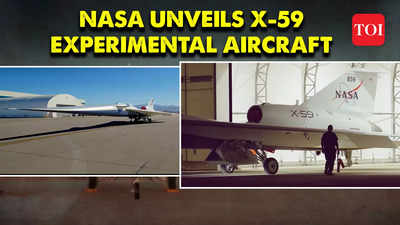
NASA Deputy Administrator Pam Melroy speaks at the roll-out for the X-59 QueSST experimental supersonic jet, at a ceremony hosted by prime contractor Lockheed Martin Skunk Works, in Palmdale, California (AFP photo)
In a significant leap forward for aviation,
Nasa
and Lockheed Martin unveiled the
X-59
quiet supersonic aircraft on Friday. This experimental plane could redefine air travel, potentially bringing us closer to the reality of commercial supersonic flights over land.
A milestone in aviation
Deputy administrator of Nasa, Pam Melroy, emphasized the rapid progress from concept to reality.
“This is a major accomplishment... Nasa’s X-59 will help change the way we travel,” she stated.
Quesst for quiet
The X-59 is central to Nasa’s
Quesst mission
, aiming to challenge the current restrictions on commercial supersonic flight over land, a ban in place for 50 years due to sonic booms' impact on communities. The X-59, flying at 1.4 times the speed of sound, is designed to reduce noise, creating just a 'sonic thump'.
Revolutionary design
The aircraft, 99.7 feet long and 29.5 feet wide, features a unique shape and cutting-edge technologies. Its lengthy, tapered nose and strategically placed cockpit, equipped with an
eXternal Vision System
instead of forward-facing windows, are key to minimizing sonic booms.
Next steps and future flights
With the rollout complete, the focus now shifts to integrated systems testing, engine runs, and taxi testing. The first flight is scheduled for later this year, with further testing at the Skunk Works facility before moving to Nasa’s Armstrong Flight Research Center.
A collaborative effort
John Clark of Lockheed
Martin Skunk Works
highlighted the collaboration between teams. "We’re honored to be a part of this journey to shape the future of supersonic travel over land alongside Nasa," he said.
Community involvement and regulatory impact
Post-testing, Nasa plans to fly the X-59 over select US cities, gathering public feedback on the noise. This data will be crucial for informing the Federal Aviation Administration and international regulators, potentially reshaping aviation rules.
More than a prototype
The X-59 is not just a prototype but a pathfinder for future quiet supersonic aircraft. Its mission is to lay the groundwork for a new era of faster, quieter air travel, bringing distant places closer in a fraction of the time.
Bottom line: The X-59 quiet supersonic aircraft marks a pivotal moment in aviation history. Its successful development and testing could open the doors to a new age of fast, efficient, and community-friendly air travel, forever changing how we connect across continents.
Watch NASA, Lockheed Martin unveil X-59: Quiet supersonic jet for Quesst mission

 1 year ago
316
1 year ago
316




























 English (US)
English (US)